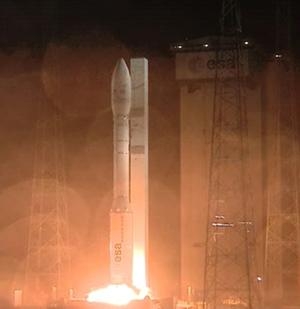Spacecraft Placed In Two Sun-Synchronous Orbits During Two-Hour Flight
Arianespace’s light-lift Vega launcher performed an intricate mission from the Spaceport in French Guiana Tuesday, successfully delivering three satellite passengers at two different Sun-synchronous orbital altitudes during a flight lasting just over two hours. It was Vega’s second mission from the spaceport, and further demonstrated the capabilities of a vehicle that completes Arianespace’s launcher family – joining its medium-lift Soyuz and heavyweight Ariane 5.

“This launch confirms the full functionality of Vega, which is totally operational and ready to offer the best service to our customers,” explained Stéphane Israël, Arianespace’s new Chairman and CEO. “With its three launchers operational at the Spaceport, Arianespace is the only launch services provider capable of placing all types of satellite payloads into all types of orbits.”
The mission, designated Flight VV02 in Arianespace’s launcher family numbering system, included numerous “firsts” for Vega. Arianespace assumed Vega operations responsibility for the first time on this mission, which followed the lightweight launcher’s February 2012 qualification flight performed under responsibility of the European Space Agency (ESA). The launch also marked the initial use of a multi-payload dispenser called VESPA (Vega Secondary Payload Adapter), which carried the Proba-V satellite atop it, while the VNREDSat-1 and ESTCube-1 spacecraft were installed inside the system. Additionally, VREDSat-1became the initial commercial satellite lofted by Vega.
In another first, the mission was the debut of the Europe Space Agency’s VERTA (Vega Research and Technology Accompaniment) flight series to demonstrate the launcher’s flexibility and versatility.
Lifting off May 6 in rainy French Guiana conditions, Vega departed the Spaceport’s SLV launch facility at the planned precise moment of liftoff at 11:06:31 p.m. local time and disappeared into the cloud cover.
After the initial powered phase performed by Vega’s three solid propellant stages (designated the P80, Zefiro-23 and Zefiro-9), the launcher’s AVUM upper stage was ignited for four separate burns during the payload deployment sequence. A final burn was planned to deorbit the upper stage – ensuring it does not remain as a debris threat. The AVUM has a bipropellant propulsion system to provide orbital injection, along with a monopropellant propulsion system for roll and attitude control.
The Proba-V satellite was released first during the flight profile, with this passenger to operate in a Sun-synchronous orbit of 820 km. Proba-V (which is named from the acronym: Project for On-Board Autonomy and Vegetation) is part of the European Space Agency’s Proba spacecraft series that supports the development of new space technologies. Its primary objective is to continue the mission performed by Earth-monitoring Vegetation instruments carried on the Spot 4 and 5 satellites – which also were launched by Arianespace – and is designed to offer global coverage every two days for data on the influence of climate, the management of resources for surface water, monitoring of changes in agricultural zones, and food security estimates.
The VNREDSat-1 optical satellite was separated in the second step of today’s mission, providing a resource for Vietnam’s initiative to create an infrastructure enabling better studies of climate change effects, improving predictions for natural disasters and optimizing natural resource management for the country. This spacecraft was built by Astrium on behalf of the Vietnam Academy of Science and Technology (VAST).
Completing the mission was Vega’s deployment of ESTCube-1, Estonia’s first satellite. The cubesat, weighing under three pounds, will extend a small conductive tether for testing of electric solar wind sail technologies, and also is to help establish an Estonian infrastructure for future space projects. It resulted from a collaboration of students from Tartu University, Estonian Aviation Academy, Tallinn University of Technology and University of Life Sciences, and was developed in conjunction with the Finnish Meteorological Institute and the German Space Center (DLR).
(Image provided by Arianespace)
 Airborne 11.05.25: Tesla Flying Car?, Jepp/ForeFlight Sold, A220 Troubles
Airborne 11.05.25: Tesla Flying Car?, Jepp/ForeFlight Sold, A220 Troubles Airborne 11.07.25: Affordable Expo Starts!, Duffy Worries, Isaacman!
Airborne 11.07.25: Affordable Expo Starts!, Duffy Worries, Isaacman! Aero-News: Quote of the Day (11.05.25)
Aero-News: Quote of the Day (11.05.25) ANN's Daily Aero-Linx (11.05.25)
ANN's Daily Aero-Linx (11.05.25) NTSB Prelim: Cirrus Design Corp SR22
NTSB Prelim: Cirrus Design Corp SR22



